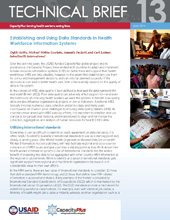
New Publication Spotlight: Establishing and Using Data Standards in Health Workforce Information Systems
Human resources information systems help countries track and support their health workforces. Information systems are successful when they support policy and management decisions and when those decisions lead to better health care—but success depends on the quality of the human resources for health (HRH) data going into the system. How can countries ensure the quality of their data? A new CapacityPlus technical brief discusses organizational, national, and international data standards that can help. In Establishing and Using Data Standards in Health Workforce Information Systems, authors Dykki Settle, Michael Webba Lwetabe, Amanda Puckett, and Carl Leitner of IntraHealth International consider different types of data standards and provide telling examples about why they matter. For example, international data standards can:
In Establishing and Using Data Standards in Health Workforce Information Systems, authors Dykki Settle, Michael Webba Lwetabe, Amanda Puckett, and Carl Leitner of IntraHealth International consider different types of data standards and provide telling examples about why they matter. For example, international data standards can:
- Facilitate regional and cross-country comparison of HRH issues
- Define standard HRH terminology
- Specify how information systems can communicate with one another to exchange health worker information across systems (interoperability).
- Accurately aggregate and analyze facility- and district-level data
- Build a system-wide data dictionary
- Create linkages so that different systems can aggregate and map the same data.
The technical brief also provides several country examples. In Uganda—prior to implementation of standards—differences in terminology and typographical errors caused the HR information system to convert 5 cadres into 34. In Kenya, a master facility list now makes it possible to map data from different systems to the same facilities. And in Ghana, a national health workforce observatory has helped the government set direction for the country’s health workforce in the areas of production, equitable distribution, management, and financing. The examples and the brief as a whole illustrate the importance of engaging and building the capacity of both data users and data producers.
Help CapacityPlus spread the word about strengthening the health workforce. Follow us on Twitter and like us on Facebook.
Related items:


